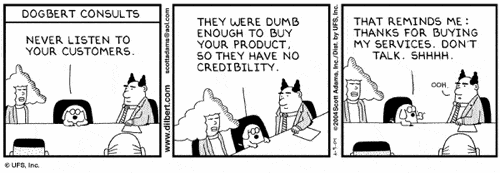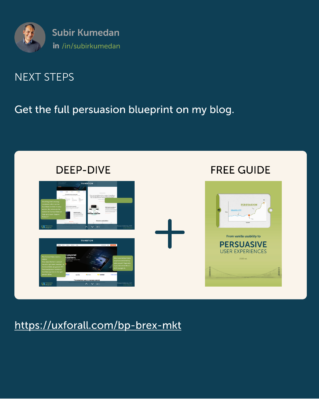As a User Experience consultant for many years, I’ve worked with several large companies. Well-established companies staffed with smart and motivated people.
However, in almost all these cases, it has been challenging to deliver great customer experiences without first solving internal issues. Over the years, I’ve observed that there are a few that are always present, regardless of company industry.
By shedding light on them, I hope people tasked with improving customer experiences in large companies can benefit from my journey in delivering successful outcomes.

1. Inward focus
In a recent project we spoke to 30+ internal executives and team members. And THREE customers.
This in a business where each deal is in the multi-millions. What’s worse was that everyone internally had little, if any, knowledge of what their prospects wanted from the site. How can you deliver a great customer experience without knowing your customers’ need?
SOLUTION: Do original customer research – with recently converted prospects AND prospects that did not.
2. Lack of purpose
Too often the site redesign is undertaken without a clear business goal. Redesigning your site to make it ‘more modern’ is not a purpose. In a Business to Business environment, you need to understand exactly when and how your site comes into play.
For one of my clients, we found out the first visits to our site and those of competitors were all about ‘getting to a shortlist’. What decision-making info is readily available. Will you make the cut?
SOLUTION: Make an internal list of the top 3-5 roles your site/app can *realistically* achieve. Then make that you overall strategy and design focus.
3. Lack of leadership in redesign projects
Eventually when a project is launched with an external design agency, there isn’t a clear internal lead. One who listens and sorts out points of contention, or overrides specific team requests.
On one project, we had 15 people – everyone with the CMO down to the project manager with an equal say in design and UX reviews. The first launch was a near disaster with the sheer amount of UI functionality barely performing on an archaic backend.
SOLUTION: Designate a project lead, not just a project manager. Empower them to prioritize and filter comments and suggestions to the design team.
4. Design by community
We’ve all been in meetings where we ‘speak for the consumer’. In reality we use the consumer as a … to get our agendas covered. IT wants to manage risk and resources. Marketing needs to hit their numbers.
Product wants to show the new cool feature that they just added. PR and Brand want to focus on the brand ethos. Executives want ‘to add value’. The customer is lucky to get a seat at this table.
SOLUTION: Collect all the needs and wishlist. Then score them against Customer Needs, Business Value and Technical Constraints to build a roadmap.
5. We know everything about our customers
Conversely, there are teams that rely on data and will tell you all about their A/B test successes and survey data. But not the underlying reasons why.
Why would a new visitor buy from us, when they can get a better deal at 800lb gorilla X? In this scenario A/B testing and analytics based optimization will only see incremental lift. To see more, you’ll need to change something your offerings, or your processes that your customer can’t get elsewhere. That ‘something’ is what data can’t help you with.
SOLUTION: The baseline solution is to have a UX person be the voice of the customer. The better solution is to conduct actual research.
6. Takes forever to get it live (or changed)
In enterprise, getting anything live on the site can be a long, arduous process. One of my enterprise e-commerce clients had a small IT team responsible for IT infrastructure and content publishing. Unsurprisingly, marketing was not very open to testing new ideas – since it would take weeks to change anything.
Contrast this with a nimble enterprise company like eBay. They have the process to test new pages quickly. An under-performing page can be pulled within hours, sometimes even minutes.
How do you stay nimble against growth-focused start-ups as other barriers fade away?
John Doe Tweet
SOLUTION: Provide more autonomy to content publishing. Alongside, offer a greater openness to fail small by testing and iterating.
7. Too much customer detail
One company I worked with had 50+ personas. Each persona was a customer segment had at least a dozen ‘facets’ included metrics to describe them. Worse they overlapped because a ‘Frugal Shopper’ could also be an ‘Impulsive Millenial’.
This caused analysis paralysis and the personas were never used internally. How many customer segments do you have – that actually interact with you on an ongoing basis. Use the 80:20 rule.
SOLUTION: Create 5-7 main customer segments. You can then create more flavors for each, so long as they are actually being used during the design and content creation process (product).
8. Paranoia about security
How about a username like A7H34JH. Or passwords that can only be 8-12 characters without a special character for one system (web application), but with special character for another (customer support). 90-day mandatory change.
If your customers are creating ‘forgot password/username’ requests almost as many times as they log in, you’re failing them.
SOLUTION: Allow friendly usernames and a password policy that is not overly restrictive that causes people to write down their passwords.
9. Lack of Executive Support
There are executives who still don’t understand or trust the web.
There are companies, even in the technology sphere, who still treat anything digital as secondary or ancillary. It’s only personal relationships, they say. Their customers don’t make buying decisions online.
This often creates a lack of conviction behind ‘digital transformation’ initiatives, resulting in a digital presence that is muddled and out of sync – internally and externally.
SOLUTION: Focus on big-picture strengths and weaknesses, with case studies showcasing competitors who are using digital to gain an edge.





Comments
Comment policy: We love comments and appreciate the time that readers spend to share ideas and give feedback. However, all comments are manually moderated and those deemed to be spam or solely promotional will be deleted.